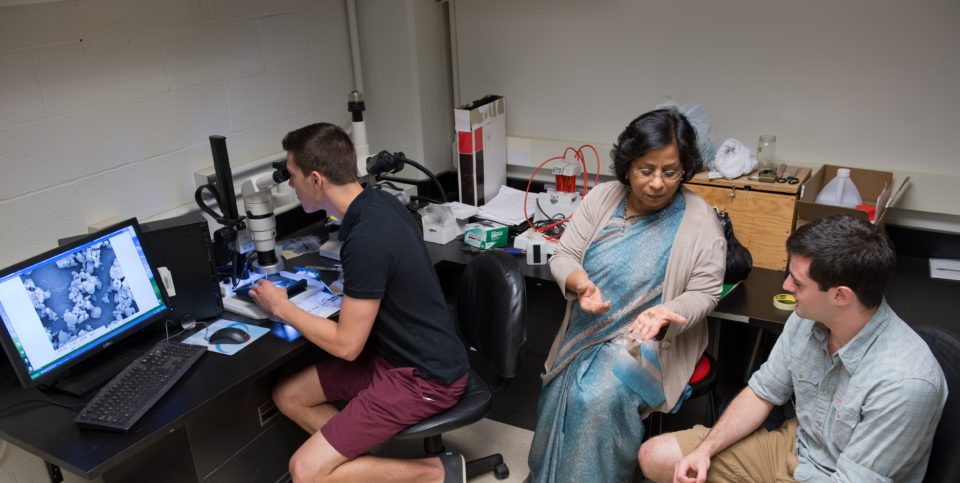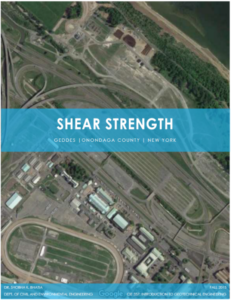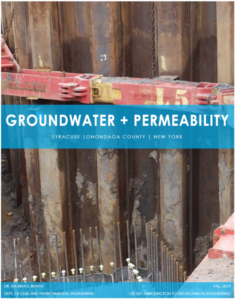Dr. Bhatia teaches at the College of Engineering & Computer Science within Syracuse University. Currently she is teaching three courses: CIE337 – Introduction to Geotechnical Engineering, CIE 584 – Designing with Geosynthetics, CIE 642 – Seepage and Earth Dams, and CIE 740 – Soil Dynamics.
CIE 337 – Introduction to Geotechnical Engineering
Dr. Bhatia has significantly restructured her undergraduate class CIE 337 in an effort to both actively engage the millennial engineering student, and evolve integration of laboratory work with the abstract theory presented in lecture. An extensive literature review began September 2014 with the participation in the “International Workshop on Education of Future Geotechnical Engineers in Response to Emerging Multi-Scale Soil-Environment Problems” workshop at the University of Cambridge. The resulting framework, starting implementation Fall 2015, was a project-based structure. Each project assigned to students was topic-specific, addressing each learning unit throughout the year: geology and ground water, field testing, compaction, groundwater & permeability, soil consolidation and settlement, and slope stability & shear strength. All projects were derived from actual sites in Upstate New York with a focus on Onondaga and Tompkins Counties.
Accompanying each project were brief 10 – 15 minute video interviews with the principal engineer for each. Each principal engineer was a graduate of Syracuse University and became additional advising assets to the students, providing them with information on: tackling geotechnical engineering problems, how to achieve success as an engineer, how best utilize their time at Syracuse University, and much more.Laboratory classes are provided to students on average of once per week for three hours. Each laboratory is integrated with the projects throughout the semester, in order to submerse the students in the subject matter and provide a hands on learning experience to supplement the theory provided in lecture.Additionally, this course implements team based learning. For the duration of the semester students are randomly assigned into teams that they will conduct laboratory testing with and complete each project assignment with. This team based approach not only prepares students for results-driven group work in future careers, but additionally provides a social incentive for students to do their best.
CIE 584 – Designing with Geosynthetics
In this course a wide variety of geosyntheitc products (geotextiles, geogrids, geonets, geomembranes, and geocomposites) are introduced and designed for a multitude of uses.
- The design areas of focus are: reinforcing structure, landfill liners, liquid empoundments, filtration, and erosion control.
- 4-5 projects will be completed throughout the semester covering the design topics listed. Each project will teach students how to effectively use geosynthetics for each circumstance, and the advantages and disadvantages to each product.
- Manufacturers are brought in throughout the semester to discuss products and specific case studies.
CIE 642 – Seepage and Earth Dams
This course focuses on the design of different aspects of earthen dams. Topics covered in lecture include: properties of earth materials, seepage & losses through dams, slope stability up & down stream, filter design & rip-rap, settlements, and instrumentation.
One real-world project is assigned to be completed throughout the duration of the course. Students will be provided data for a location and produce a comprehensive design report and thorough analysis for one dam.
CIE 740 – Soil Dynamics
During this course, students will explore how earth material performs under vibration or during an earthquake. Lecture topics are: seismology, theory of vibration, wave propagation through soils, liqufaction & settlement during an earthquake. Students will learn and practice the rehabilitation of earth dams to improve saftey, and seismic design of: retaining walls, shallow & deep foundation, and earthen dams.


